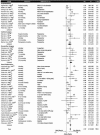Hypoalbuminemia in acute illness: is there a rationale for intervention? A meta-analysis of cohort studies and controlled trials
- PMID: 12616115
- PMCID: PMC1514323
- DOI: 10.1097/01.SLA.0000055547.93484.87
Hypoalbuminemia in acute illness: is there a rationale for intervention? A meta-analysis of cohort studies and controlled trials
Abstract
Objective: To determine whether hypoalbuminemia is an independent risk factor for poor outcome in the acutely ill, and to assess the potential of exogenous albumin administration for improving outcomes in hypoalbuminemic patients.
Summary background data: Hypoalbuminemia is associated with poor outcomes in acutely ill patients, but whether this association is causal has remained unclear. Trials investigating albumin therapy to correct hypoalbuminemia have proven inconclusive.
Methods: A meta-analysis was conducted of 90 cohort studies with 291,433 total patients evaluating hypoalbuminemia as an outcome predictor by multivariate analysis and, separately, of nine prospective controlled trials with 535 total patients on correcting hypoalbuminemia.
Results: Hypoalbuminemia was a potent, dose-dependent independent predictor of poor outcome. Each 10-g/L decline in serum albumin concentration significantly raised the odds of mortality by 137%, morbidity by 89%, prolonged intensive care unit and hospital stay respectively by 28% and 71%, and increased resource utilization by 66%. The association between hypoalbuminemia and poor outcome appeared to be independent of both nutritional status and inflammation. Analysis of dose-dependency in controlled trials of albumin therapy suggested that complication rates may be reduced when the serum albumin level attained during albumin administration exceeds 30 g/L.
Conclusions: Hypoalbuminemia is strongly associated with poor clinical outcomes. Further well-designed trials are needed to characterize the effects of albumin therapy in hypoalbuminemic patients. In the interim, there is no compelling basis to withhold albumin therapy if it is judged clinically appropriate.
Figures




References
-
- Herrmann FR, Safran C, Levkoff SE, et al. Serum albumin level on admission as a predictor of death, length of stay, and readmission. Arch Intern Med. 1992; 152: 125–130. - PubMed
-
- McCluskey A, Thomas AN, Bowles BJ, et al. The prognostic value of serial measurements of serum albumin concentration in patients admitted to an intensive care unit. Anaesthesia. 1996; 51: 724–727. - PubMed
-
- Reinhardt GF, Myscofski JW, Wilkens DB, et al. Incidence and mortality of hypoalbuminemic patients in hospitalized veterans. JPEN J Parenter Enteral Nutr. 1980; 4: 357–359. - PubMed
-
- Margarson MP, Soni N. Serum albumin: touchstone or totem? Anaesthesia. 1998; 53: 789–803. - PubMed
-
- Knaus WA, Wagner DP, Draper EA, et al. The APACHE III prognostic system. Risk prediction of hospital mortality for critically ill hospitalized adults. Chest. 1991; 100: 1619–1636. - PubMed
Publication types
MeSH terms
Substances
LinkOut - more resources
Full Text Sources
Other Literature Sources
Medical

